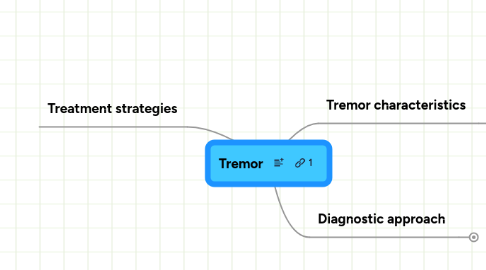
1. Tremor characteristics
1.1. Rest tremor
1.1.1. e.g. tremor occurs when hands rest on lap
1.1.2. often increases with mental stress
1.1.3. decreases with a goal directed movement
1.2. Action tremor
1.2.1. Definition
1.2.1.1. occurring during a voluntary contraction of muscles
1.2.2. Classification
1.2.2.1. Kinetic
1.2.2.1.1. intention tremor
1.2.2.2. Isometric
1.2.2.2.1. Isometric tremor occurs as a result of muscle contraction against rigid stationary object
1.2.2.3. Postural
1.2.2.3.1. occurs when voluntarily holding a position against gravity: e.g. with arms extended in front of the body
1.2.2.4. Task specific
1.2.2.4.1. e.g. while writing
1.3. Both: rest + action
1.4. Frequency
1.4.1. >6Hz = fast
1.4.2. <6Hz = slow
1.5. Regularity
1.5.1. Regular
1.5.2. Jerky
1.6. Amplitude
1.6.1. fine
1.6.2. Coarse
1.7. Axis
1.8. associated symptoms
1.9. Description
1.9.1. Which bodyparts are involved?
1.9.2. When is it present?
1.9.3. When does it get worse?
2. Diagnostic approach
2.1. Rest tremor
2.1.1. Think at least of Parkinson's Disease
2.1.2. Associated symptoms
2.1.2.1. Is there bradykinesia?
2.1.2.2. Is there rigidity?
2.1.2.3. Is gait affected?
2.1.2.4. Is there arm-swing asymmetry?
2.2. intention tremor
2.2.1. Think at least of
2.2.1.1. Alcoholism
2.2.1.2. Multiple Sclerosis
2.2.1.3. Stroke
2.2.2. Associated symptoms
2.2.2.1. Is there imbalance?
2.2.2.2. Is there dysarthria?
2.2.2.3. Is there ataxia?
2.2.2.4. Acute onset?
2.2.2.5. Relapsing or remitting?
2.3. Postural tremor
2.3.1. Think at least of
2.3.1.1. Anxiety & panic attacks
2.3.1.1.1. especially in younger patients
2.3.1.2. thyrotoxicosis
2.3.1.3. Essential tremor
2.3.1.3.1. family history positive
2.3.1.3.2. improves with alcohol use
2.3.2. Associated symptoms
2.3.2.1. eye signs
2.3.2.2. rapid pulse
2.3.2.3. goitre
2.3.2.4. chest discomfort
2.3.2.5. palpitations
2.3.2.6. is there improvement on alcohol use?
2.3.2.7. is there a family history?
